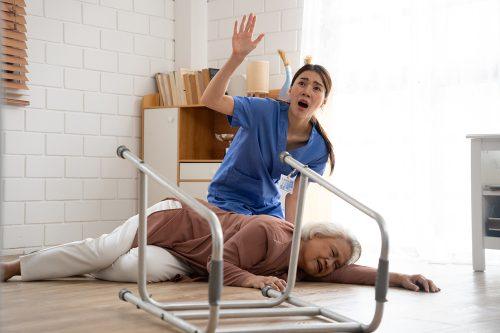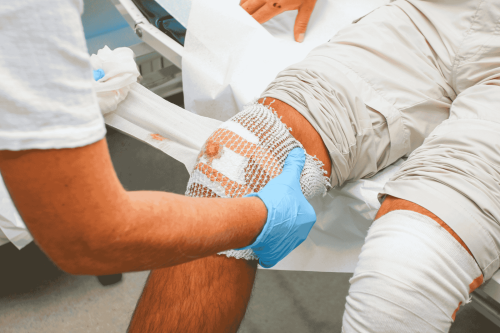In assisted living facilities, safety isn’t just a checkbox—it’s a daily commitment. Residents are often older adults with mobility issues, memory loss, or chronic health conditions, making them more vulnerable to common accidents in assisted living. One slip, one missed step, or one forgotten medication can quickly turn into a medical emergency.
In fact, nearly 14 million older adults in the U.S.—about 28%—reported experiencing a fall in just one year, according to the CDC.
The good news? Most accidents in assisted living facilities are preventable.
With the right staff training, better facility practices, and a proactive mindset, your team can reduce risks, protect residents, and create a safer, more supportive environment for everyone.
Let’s take a closer look at five of the most common accidents in assisted living communities—and what you can do to prevent them.
How to Prevent 5 Common Accidents in Assisted Living Facilities

-
Falls and Slips
Falls are one of the most common accidents in assisted living—and also the most dangerous. For seniors, even a minor fall can lead to fractures, head injuries, and loss of independence.
Why They Happen:
-
Poor lighting in hallways or bathrooms
-
Wet or uneven floors
-
Lack of grab bars or railings
-
Improper footwear or unsafe slippers
-
Residents rushing without assistance
How to Prevent Falls:
-
Install non-slip flooring and keep walkways dry and clutter-free
-
Add grab bars in bathrooms, handrails in hallways, and encourage proper footwear
-
Improve lighting in common areas and rooms
-
Conduct regular fall risk assessments for each resident
-
Train staff to assist residents when walking or transferring from beds and chairs
Falls may be frequent incidents, but with the right attention and care, they don’t have to be.
-
-
Medication Errors
Medication errors are another one of the common accidents that can have serious consequences in assisted living. Residents often take multiple prescriptions, and errors can lead to allergic reactions, side effects, or hospitalizations.
Why They Happen:
-
Misreading labels or charts
-
Rushed staff trying to stay on schedule
-
Lack of a double-check process
-
Outdated or unclear medication records
How to Prevent Medication Errors:
-
Use electronic medication management systems to track doses and schedules
-
Establish a “double-check” rule before administering meds
-
Keep medication records updated and review them regularly
-
Provide specialized medication safety training for all caregivers
-
Assign medication responsibilities to trained, authorized staff only
When medication is handled carefully, it prevents one of the most avoidable yet potentially dangerous frequent incidents in care settings.
-
-
Choking Incidents
Choking is one of the more silent but life-threatening common accidents in assisted living. Many seniors have difficulty chewing or swallowing due to cognitive decline or medication side effects.
Why They Happen:
-
Serving food that’s difficult to chew or swallow
-
Residents eating too quickly or without supervision
-
Staff unaware of dietary restrictions or swallowing difficulties
How to Prevent Choking:
-
Conduct swallowing assessments for all residents upon admission and regularly thereafter
-
Offer modified diets (soft or pureed foods) for those at risk
-
Train staff in choking response techniques like the Heimlich maneuver
-
Ensure staff know which residents require supervision during meals
-
Create a calm, distraction-free environment during mealtime
A few small changes to meal prep and supervision can prevent one of the most overlooked common accidents in daily care.
-
-
Burns and Scalds
Burns from hot water, food, or kitchen appliances are also frequent avoidable incidents in assisted living settings—especially in bathrooms and dining areas. Seniors are particularly vulnerable due to slower reaction times or reduced sensitivity to heat.
Why They Happen:
-
Hot water temperatures set too high
-
Spilling hot drinks or soup
-
Using unsafe appliances or leaving them unattended
-
Staff unaware of temperature sensitivity in certain residents
How to Prevent Burns:
-
Set water heaters to a safe maximum temperature (usually 120°F or lower)
-
Use temperature-regulated faucets and check water before bathing residents
-
Serve hot food and drinks in spill-resistant containers
-
Keep residents away from stovetops, toasters, or coffee machines
-
Train staff to monitor for signs of burns and respond immediately
Careful handling of hot liquids and better appliance safety can prevent these common accidents before they cause harm.
-
-
Wandering and Elopement
Wandering is a serious concern in memory care and assisted living, ranking high among frequent incidents that lead to panic and risk of injury. For residents with dementia, one unlocked door can mean serious consequences.
Why They Happen:
-
Residents confused about their location or time of day
-
Inadequate supervision or staff distractions
-
Broken or easily bypassed exit alarms
-
Facility layout that allows unsupervised access to exits
How to Prevent Wandering:
-
Secure exterior doors and install door alarms or motion sensors
-
Use ID bracelets or GPS trackers for high-risk residents
-
Create safe wandering paths inside the facility with locked perimeter areas
-
Keep resident care plans updated with notes on wandering risk
-
Train staff on red flags for elopement behavior and how to respond
Wandering isn’t always avoidable—but with planning and vigilance, it becomes one of the common accidents that you can anticipate and manage effectively.
-
Prevention Starts with Preparedness
Every accident on this list shares something in common: it can be minimized or avoided with the right training, awareness, and support. Caregivers are busy. Mistakes happen. But facilities that invest in accident prevention training empower their staff to make better decisions, react quickly, and spot risks before they turn into emergencies. That means fewer injuries, fewer hospital visits, and a safer, more reassuring environment for residents and their families.
Preventing accidents isn’t just about avoiding liability—it’s about creating a community where older adults feel safe, supported, and respected. When residents feel secure and families trust your care, it reflects in everything—from your facility’s ratings to staff morale and long-term success. But safety isn’t automatic—it’s built through consistent training, smart systems, and a culture of care.
That’s where we come in.
At American Medical Compliance, we help assisted living facilities ensure compliance, boost operational efficiency, and foster trust through targeted, practical training programs.
Have a large team?
We offer customized course development at no cost to meet your specific needs and ensure your entire staff is trained, aligned, and ready to protect your residents.
Enroll your team today and build a safer future—one well-trained caregiver at a time. Click here.



